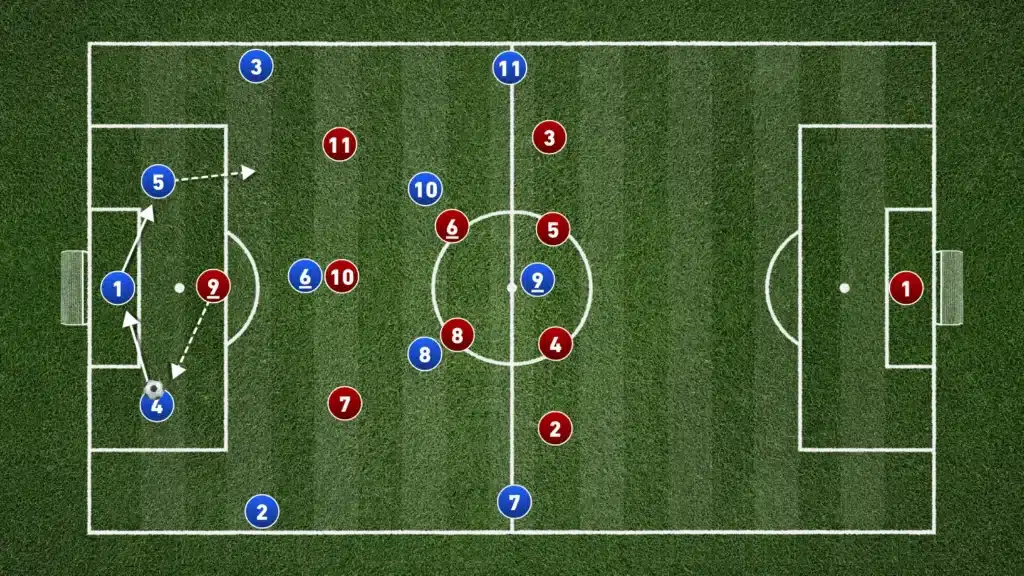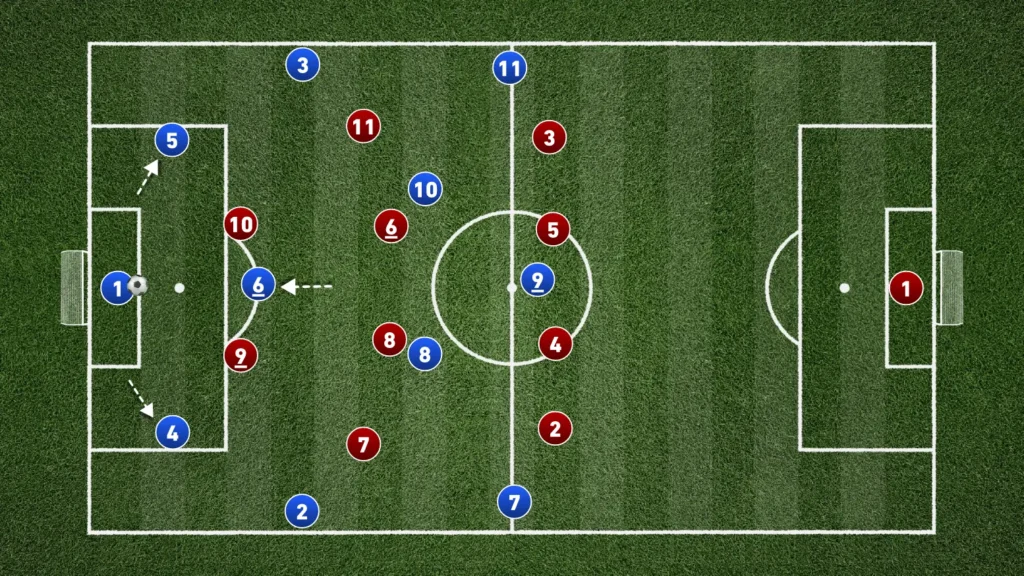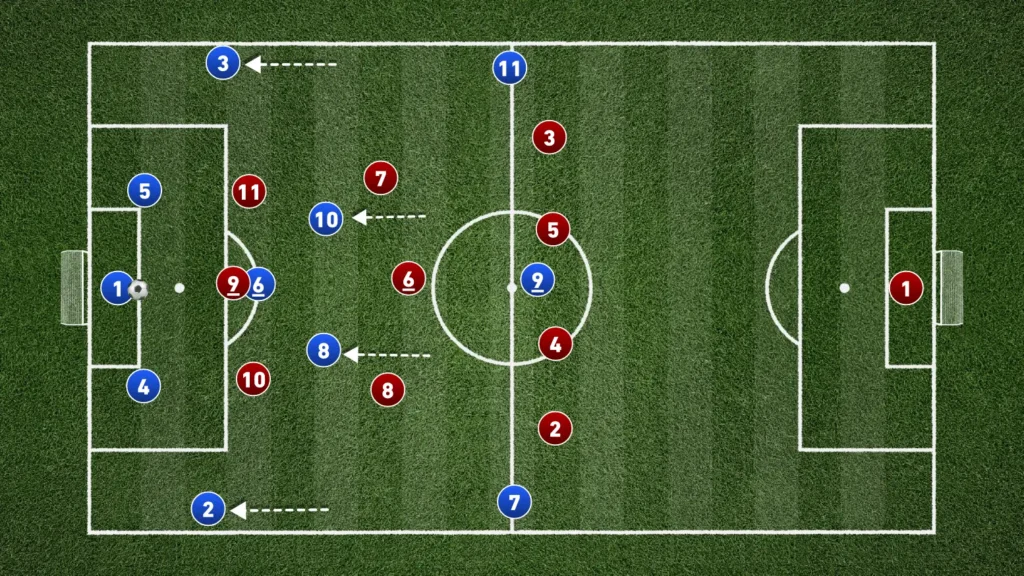In modern football, the ability to build up play from the back has become one of the most important ways for teams to control matches and create goal-scoring opportunities. Teams like PSG, Manchester City, and Liverpool have revolutionized how we think about progressing the ball from the defensive third through the middle third and into the final third with purpose and precision.
Mastering build-up play is crucial at all age groups and levels of the game, as it enables the attacking team to maintain possession under pressure, dictate the tempo of the game, and create numerical advantages in various areas of the pitch. When executed properly, build-up play forces the defending team to commit players forward, opening spaces that can be exploited with clever passing movements and positional play.
A well-organized build-up phase teaches players how to create space, make smart decisions under pressure, break through the opposition lines, and become better overall footballers. This tactical approach has become a cornerstone of attacking football at the highest levels, where teams’ ability to build from the back often determines their success.
What Build-Up Play Means
Build-up play refers to the systematic progression of the ball from the defensive third through organized passing and movement, to create attacking opportunities while maintaining possession of the ball. The build-up phase begins when the team gains possession in their own defensive third, and it involves moving the ball forward through structured passing patterns that break opposition lines.
The core principle of build-up play revolves around creating numerical superiority in specific areas of the pitch, allowing the attacking team to progress play despite the pressure from the opponents. Manchester City provides an excellent example of this concept – their central defenders spread wide during goal kicks, the defensive midfielder drops between them to create overloads, and fullbacks position themselves wide to receive the ball in space.
This systematic approach to the build-up phase allows them to consistently find passing options and advance the ball into more dangerous areas. Another prime example comes from teams that use their central midfielder as a deep-lying playmaker during the build-up.
The player drops into the defensive third to collect the ball, creating an extra passing option and helping the team progress through the midfield line with short passes and combination play.
Beating Different Types of Presses
When it comes to build-up play, understanding how many opposition players are pressing is crucial for determining your team’s shape, passing options, and decision-making. Here’s how to approach each scenario:
1 Presser
When only one forward is pressing, your team has a clear numerical advantage in the defensive line. The goalkeeper and central defenders should calmly move the ball around, drawing the press toward one side before switching play to create space in other areas.

This patient approach allows you to find a free central midfielder or progress play to the wing, where fullbacks can advance the ball forward. The key coaching points here involve encouraging players to stay composed and resist the urge to rush.
Use the extra player advantage to create space through ball circulation, then switch the play to the other direction when the opposition player commits to one side.
2 Pressers
With two players pressing, typically in a front two formation like the 4-4-2, your central defenders must stay wide while the goalkeeper becomes a crucial support player. Create passing triangles by having a defensive midfielder drop between the two forwards.

This movement provides additional passing options and helps the team progress play through the middle. The attacking team should focus on quick passing movements between the goalkeeper, central defenders, and the dropping defensive midfielder.
Once the ball moves past the first line of pressure, fullbacks can provide width while central midfielders position themselves to receive the ball in space.
3 Pressers
When three players press high up the pitch, the opposition aims to force mistakes by cutting off short options and pressing aggressively in the defensive third. To counter this intense pressure, teams must create overloads by dropping additional midfielders or fullbacks to offer support.

However, when facing an aggressive three-player press, teams should also recognize when to bypass the pressure entirely. Sometimes the best option is to play long balls into targeted spaces behind the opposition press, allowing forwards or attacking midfield players to receive the ball higher up the pitch.
This approach acknowledges that not every build up phase needs to go through short passing, sometimes the direct approach creates better attacking opportunities while avoiding unnecessary risk in your own defensive third. This is all going to depend on how many players are pressing.
What are the Key Principles of Build Up Play?
Good Spacing and Positioning
First, spatial awareness and positioning form the foundation for good build-up play. Players must maintain proper distances to create passing lanes while avoiding congested areas that make it easier for opposition players to press multiple teammates simultaneously.
The defensive line should spread wide to create space, while midfield players position themselves to receive the ball with an open body shape that allows them to see the next pass.
Support Shapes (Triangles and Diamonds)
Next, creating triangles and diamond shapes around the ball carrier provides them with multiple passing options and helps the team move the ball effectively around the opposition’s pressure. When the defensive midfielder drops, it forms a triangle that gives the ball carrier more passing options.
Similarly, when fullbacks provide width and central midfield players position themselves between lines, it creates diamond shapes that allow for quick combination play and forward progression.
Switching Play at the Right Time
In addition, knowing when to switch the play forces the defending team to shift across the pitch, opening gaps in the midfield line and creating space in wide areas. Players must recognize when to change the point of attack using long balls or quick short passes to the other direction.
The timing of these switches is crucial – too early and the opposition can easily adjust, too late and the space may have already closed.
Staying Composed Under Pressure
Finally, maintaining possession under pressure requires technical ability, decision-making skills, and mental composure. Players must first develop a strong foundation of technical skills, learn to receive the ball with their back to goal, use their body to shield the ball from opposition players, and find the next pass quickly.
This involves scanning before receiving the ball, positioning the body correctly, and having predetermined passing options based on the opposition’s movement, your teammate’s movement, and the open space.
What are Common Mistakes to Avoid During Build Up Play?
Rushing the Play
One of the most frequent errors in the build-up phase is players rushing their decisions when under pressure from opposition players. When teams panic and attempt to progress the ball too quickly, they often lose possession in dangerous areas or fail to create meaningful attacking opportunities.
Instead, players should stay patient, use the numerical advantages created by proper positioning, and wait for the right moment to play forward.
No Options for the Ball Carrier
Another critical mistake that happens during build-up play is when teammates fail to provide support for the player in possession. If the ball carrier has no clear passing options, they become vulnerable to the opposition press and may be forced into poor decisions.
Support players must constantly adjust their positions to create passing lanes and offer safe options, particularly when the ball is in the defensive third.
Misreading Pressing Triggers
Finally, oftentimes during build-up play, players fail to recognize when the opposition is about to press, leading to rushed decisions or being caught in possession. Understanding pressing triggers – such as a pass back to the goalkeeper, a slow pass along the defensive line, or a player receiving with their back to goal – helps teams prepare for pressure and adjust their positioning accordingly.
Training sessions should focus on recognizing these moments and responding with appropriate movement and passing patterns. Teams also struggle when they don’t recognize the right moments to bypass the press entirely.
Sometimes the opposition press is so intense that attempting to build through short passes becomes counterproductive. In these situations, playing long balls to targeted areas or using direct passes to centre forwards can be more effective than forcing the ball through congested areas.
Conclusion
To wrap up, build-up play involves the systematic progression of the ball from the defensive third through organized passing and movement to create attacking opportunities while maintaining possession. Teams must adapt their approach based on how many opposition players are pressing – using numerical advantages with 1-2 pressers or creating overloads and sometimes bypassing pressure entirely when facing 3 pressers.
The key principles include maintaining good spacing and positioning, creating support shapes like triangles and diamonds around the ball carrier, switching play at the right moments, and staying composed under pressure. Some of the most common mistakes to avoid include rushing decisions under pressure, failing to provide adequate support options for the ball carrier, and misreading pressing triggers that indicate when the opposition is about to apply pressure.
By mastering these fundamentals, teams can transform their ability to build up play, control matches, and create quality goal-scoring opportunities from any area of the pitch.
